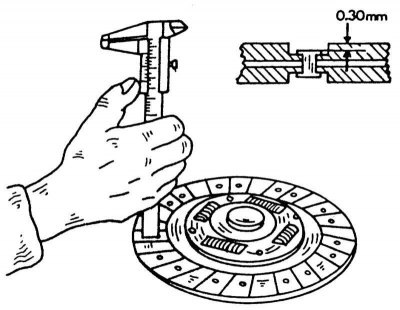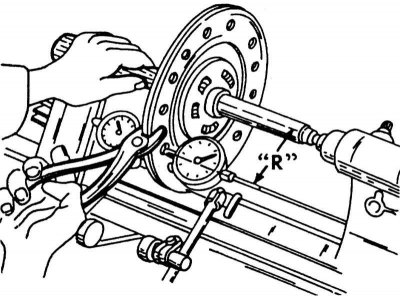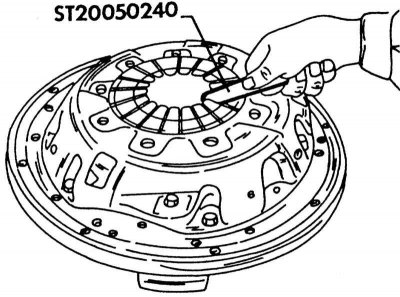2. Check the clutch linings for their usability by measuring the distance from the top surface of the lining to the top side of the rivets (illustration below). If the size is less than 0.30 mm, the disc should be replaced. The disc should be replaced, and if this size approaches the wear limit.

Measuring the thickness of the lining of the driven disk to the heads of the rivets.
3. To check the runout of the driven disk, it should be clamped on a suitable rod or clutch shaft between the centers of the lathe. Position the dial indicator next to the disc so that the dipstick rests on the edge of the disc, i.e. 95 mm (carbureted engine) or 102.5 mm (other engines) from the midpoint of the disk ("R" in the illustration below). Rotate the disc slowly and take readings from the meter. If the value is greater than 1.0 mm, the disc can be carefully leveled with forceps. Otherwise, replace the disk. Check the mating of the driven disk hub on the splined connection of the clutch shaft. To do this, put on the disk and grab the outer edge with your thumb and forefinger. In the direction of rotation, move the disk back and forth. If there is more than 0.8 mm play, there is wear in the spline connection. The reason for this in most cases should be sought in the driven disk. Check the inner ends of the diaphragm spring pins for wear. If there are deep signs of wear, the entire clutch must be replaced. The ends of the diaphragm spring must be at the same level within 0.8 mm.

Measuring the beating of the driven disk. Set indicator according to radius size "R". If required, align slightly with tongs.
4. Bent fingers can be straightened out. For this, a special tool is usually used, as shown in the illustration below, however, it is possible to cut a slot in the steel strip and bend the ends, as shown in the illustration.

Bending the ends of the fingers of the diaphragm spring.